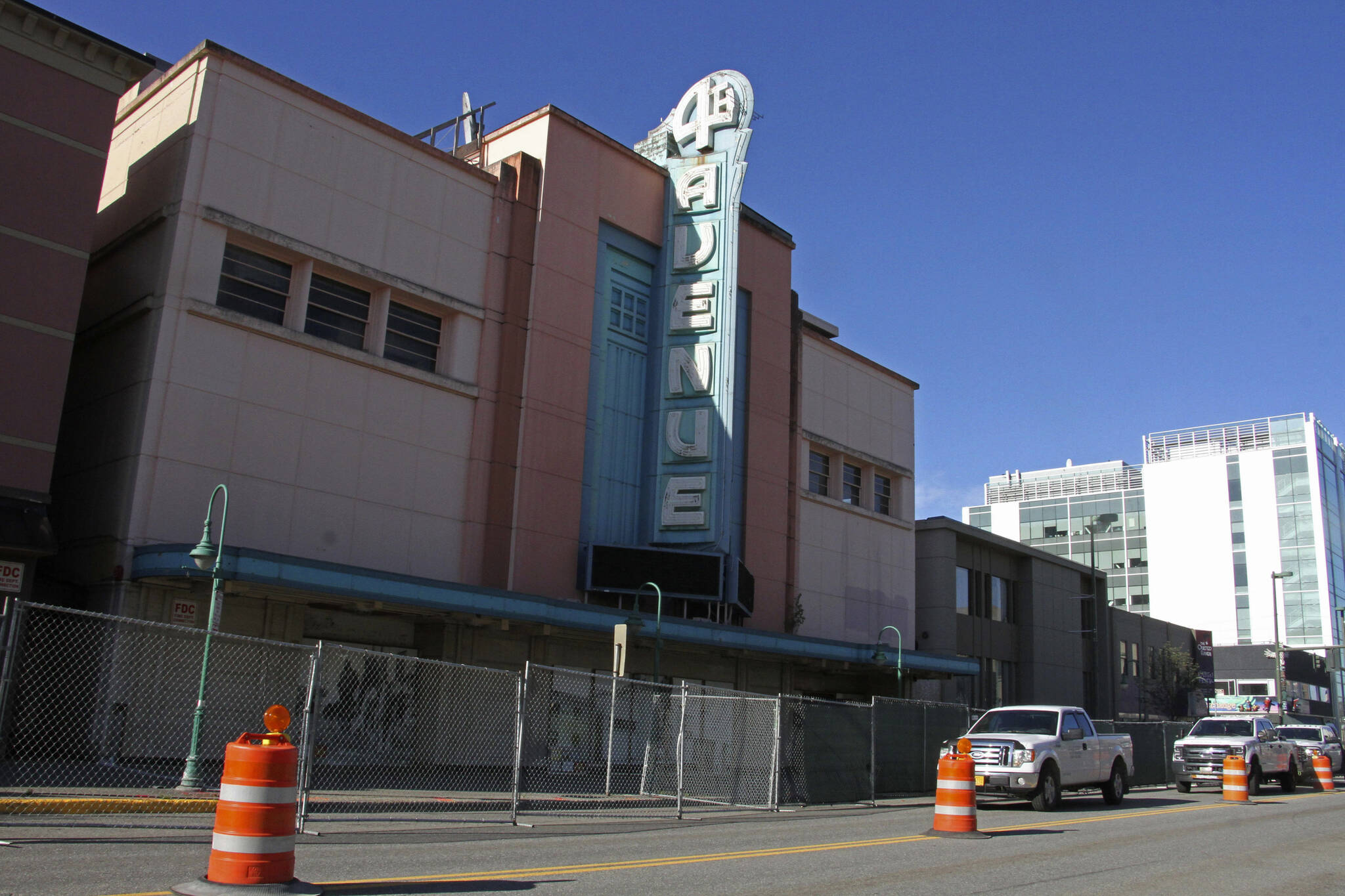By Mark Thiessen
Associated Press
ANCHORAGE — Demolition is scheduled to begin this week on a once-opulent downtown Anchorage movie theater designed by the architect of Hollywood’s famed Pantages Theatre.
Anchorage entrepreneur Austin “Cap” Lathrop opened the 4th Avenue Theatre, with nearly 1,000 seats, on May 31, 1947, with a showing of “The Jolson Story.” The art deco theater became the centerpiece of the downtown historic district. But the last movie was shown over 40 years ago, and the building has sat vacant for nearly half that time.
The building’s current owners say bringing the building back to a usable venue after sitting vacant for more than 15 years is too costly, among other problems, and its use as a single screen movie theater is an outmoded business model.
Instead, building owners Derrick Chang and Terence Chang said in statement earlier this year that they will attempt to salvage the impressive artwork inside the building and the iconic 4th Avenue art deco neon sign and incorporate them in a new $200 million redevelopment plan for the block that will include housing, office space, a hotel, retail and entertainment venues.
The Changs did not respond to messages from The Associated Press.
“It is a very significant building, architecturally, its association with Cap Lathrop and as a historic icon in Anchorage itself,” said Judith Bittner, the state historic preservation officer. “I think that the interior and exterior are unique and worthy of preservation.”
Efforts over the years to save the theater weren’t successful, including a failed voter initiative to provide funding.
The realization that efforts to save the theater are over is sinking in for some who have fought to preserve the five-story, nearly 11,500-square-foot building, especially after fencing went up around the theater this week and traffic was restricted around the building.
“I think it’s a foregone conclusion that this is the end,” said Trish Neal, president of the Alaska Association for Historic Preservation. “I think there’s people grieving all over the state and beyond.”
Added Sam Combs, a historic preservation architect: “It’s going to destroy the historic center of our city.”
Lathrop was making a substantive statement by beginning construction on the theater in 1941, two years after the U.S. Census put Anchorage’s population at about 3,500. Alaska was still a territory at the time, long before Anchorage became the state’s largest city and an aviation hub between the U.S. and Asia.
Alaska’s future was not clear at that time, but Bittner said Lathrop had a vision that Alaska was going to become something — and he put his considerable fortune behind that belief.
“It was in a sense a comment to Alaska saying, ‘I believe in Alaska, I believe in its future, and we can aspire to greater things,’” Bittner said.
B. Marcus Priteca, a Seattle architect who designed theaters for early theater chain owner Alexander Pantages, including the iconic Hollywood theater in 1929, was hired to design the new Anchorage movie theater. Work began in 1941 but was paused during World War II.
The interior was lush, featuring high-end décor and love seats at the end of alternating rows.
A gold leaf mural of Alaska’s Mount McKinley, North America’s tallest mountain now named Denali, graced the lobby.
Silver and gold murals featuring Alaska scenes by Anthony Heinsbergen and Frank Bouman of Los Angeles were featured in the main theater. Two floor-to-ceiling murals framed the stage and screen, according to the Friends of the Fourth Avenue Theatre website. Twinkling lights illuminated the Big Dipper and North Star constellations on the ceiling.
The theater was lacking one major detail, however. Lathrop thought concession stands were unseemly and didn’t include one, forcing kids to visit the Woolworth’s at the end of the block to stock up on candy before hitting the movie.
The building was more than just a movie theater. Lathrop’s TV and radio stations had their studios there, plus there was room for offices and an attic on the fourth floor. The fifth floor wasn’t added until about 1960, and it became a penthouse.
The building is solid with a lot of poured concrete, Bittner said.
“It was built to last,” she said. “They’re going to have a challenge taking down some of that concrete.”
That solid base could be one reason the theater remained standing while streets and buildings throughout Anchorage collapsed after the magnitude 9.2 earthquake on Good Friday 1964, which is the second strongest earthquake on record.
The 4th Avenue Theatre’s movie projectors went silent in the 1980s, and the building was used as an events venue through the early part of this century.
Neal said one remaining hope to save the building from the wrecking ball is if Republican Gov. Mike Dunleavy would declare it a state historic site and seek written consent from the owners for the designation.
“The Alaska Historical Commission urges you and the Alaska Department of Natural Resources to take all action necessary and authorized by the Alaska Constitution and Alaska Historic Preservation Act to ensure that the historic character and value of the 4th Avenue Theatre is protected and preserved for future generations,” Bittner said in a July 12 letter addressed to Dunleavy and obtained by the AP.
“The Governor’s office never received the letter from the historical commission. Therefore, there is no official request,” Dunleavy spokesperson Jeff Turner said in an email to the AP on Thursday.
Anchorage Mayor Dave Bronson backs the changes for downtown, said his spokesperson, Corey Allen Young.
“The mayor supports plans to bring new development and life to 4th Avenue with respect to the historical nature of the theater. The developers have agreed to preserve as much of the artwork as possible, and recreate the historical landmark sign on 4th Avenue,” he said in an email.
Bitner said she appreciated the Changs’ efforts to save the iconic sign and murals, but however it is used in the future, it will be art and not part of a building.
“The context in which they were created is gone,” she said. “Once it’s gone, it’s gone forever.”


